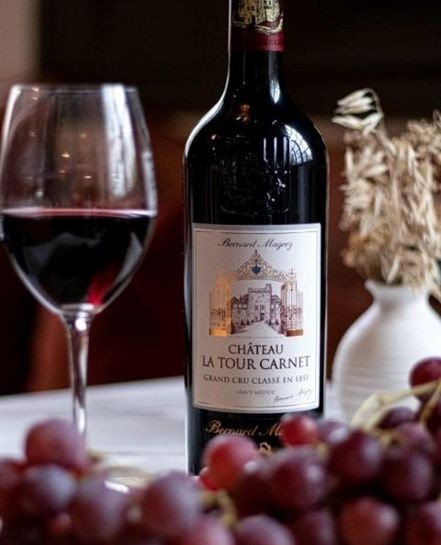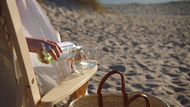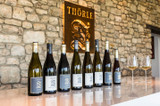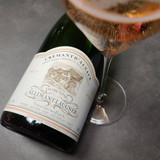Jul 4th 2025
Coastal Influence: How Ocean Breezes Shape Wine Flavor Profiles
There's something special about being next to the ocean. The salty air on your skin, the cool breeze dissipating the morning fog, and the distant sound of crashing waves bring serenity to the silence. That oceanic charm isn't just in the air — it makes its way into the vineyards and creates what we know as coastal wine. The sea's rhythm influences these bottles, caressed by the ocean breeze, and born from a maritime influence.
In this blog, we will look at the science and spirit of coastal wines — ocean winds influencing their flavor, where the leading producers of coastal wines are, which foods make the best pairings, and how you can shop the best coastal wines here at Woodland Hills Wine Company.
Why Does the Ocean Matter for Coastal Wine?
In wine, geography isn't significant; it's profound. And few natural phenomena have a greater impact than the sea. Proximity to the coast behaves like nature's air conditioning system, softening temperatures, lengthening ripening seasons, and imbuing grapes with crisp, refreshing acidity. The outcome? Wines that sing with refinement, nuance, and terroir-driven personality, genuinely exceptional wine character.
Rapid Advantages of Seaside Vineyards:
- Grape ripeness delayed = greater depth and layered complexity
- Increased natural acidity = wines that taste fresh and vibrant
- Subtle aromatics = intense, terroir-expressive bouquets
How Do Cool Sea Breezes Shape Wine Flavor?
Have you ever wondered why coastal Pinot Noirs are so vibrant? The cold winds are part of it.
- Wind stress can stimulate vines to grow grapes with thicker skins, which leads to higher phenolics, think richer textures and a deeper color in reds.
- Combined with fog and clouds, it helps lower sugar levels while allowing a higher acidity, which is what we like to see in crisp whites!
Here’s a micro-example: take a Sonoma Coast Pinot Noir and an inland Napa Pinot Noir. From the same year, the Sonoma Pinot is more likely to display bright red fruit, earthiness &, while the Napa will be ripe cherry and spice.
Which Coastal Regions Deliver Distinctive Wine Profiles?
Here's our handpicked world tour of legendary coastal wine regions — all filled with personality defined by the ocean. Hungry for a sip? They're all at your fingertips on our Shop page.
- Sonoma Coast, California: Shielded with Pacific fog, the area yields poised, bright, and ineluctably coastal wines. Consider zesty, sea-breeze-kissed Chardonnays and Pinot Noirs that weigh red fruit against earthy, savory nuance.
- Casablanca Valley, Chile: Chilly air funnels down this coastal valley, producing Sauvignon Blancs of electrifying acidity, bright citrus, and that grassy crackle. A snappy, refreshing quaff every time.
- Rías Baixas, Spain: Albariño flourishes in salty fogs and granite soils along the windswept Atlantic shore. The result? Whites that are floral, sea-salted, and bracingly crisp, essentially made for shellfish.
- Margaret River, Australia: The Indian Ocean's refreshing breeze flavors this untamed western corner. Cabernet Sauvignon and its blending colleagues arise refined, with herbaceous lift, blackcurrant fruit core, and smooth tannins.
- Loire’s Muscadet Sèvre-et-Maine, France: This beach darling produces sublime whites with seashell minerality, bright lemon, and the lightness that makes oysters taste even more delightful. Don't underestimate the low profile; these are hidden gems.

Flowers Chardonnay Sonoma Coast 2023
Chardonnay from Sonoma Coast, Sonoma County, California

Domaine de la Louvetrie Muscadet Sèvre et Maine Le Fief du Breil 2017
Melon de Bourgogne from Muscadet, Loire, France
What Signature Flavors Define Coastal White Wines?
Let’s break down what your palate can expect when sipping coastal whites:
- Sonoma Coast: Lemon curd, wet stone, and pear
- Casablanca Valley: Grapefruit, green pepper, lime zest
- Rías Baixas: Saline, white peach, honeysuckle
- Loire Muscadet: Citrus pith, crushed shell, almond
These wines are all about flavor that speaks of place — crisp, clean, and effortlessly food-friendly.
How Do Ocean-Influenced Red Wines Taste Different?

Coastal reds have a freshness that inland reds cannot match. They can show brighter fruit, especially with vivid flavors like red currant, raspberry, or cranberry. Coastal reds also have that refreshing, crunchy acidity due to the cooling marine influences on the grapes. This acidity lends the wines a vibrancy and lift in every drop, and with soft light tannins, these reds can feel a silkier presence, perfect for pairings with al fresco dinners on a summer's night or toasting to the sunset while seated by the ocean.
Consider the difference between a coastal Pinot Noir and a Syrah from a warm climate. They are both red wines but come from very different dialects of flavor; coastal Pinot Noir will experience maritime influences, and has flavors of cherry and cranberry fruit. It has a high acidity and fresh body with soft, supple tannins — the wine whispers elegance.
On the other hand, Syrah from a warm climate will explode with flavors of blackberry and plum, with moderate acidity and firmer tannins. With its fuller-bodied structure, this red wine from the Skillet has more of a presence—a great chance to see coastal finesse against sun-drenched intensity side-by-side.
Food Pairing Guide: Best Dishes for Coastal Wines
Coastal wines, be they from New Zealand, California, Oregon, Washington, Maine, or anywhere else, shine in tandem with the correct bites, whether it’s a breezy beach picnic or a formal dinner at home.
- For Whites: Crisp and oceanic. If you're having oysters on the half shell (huge briny highlights), ceviche with lime and cilantro (zippy acidity), or goat cheese on crostini (creamy, floral), there is no better pairing.
- For Reds: Light, yet slightly layered reds pair perfectly with grilled salmon glazed in miso; herb-roasted chicken, skin golden; or a mushroom risotto laced with thyme — ode to the way its fruit elevates the wine and its gentle tannins are balanced.

Craggy Range Sauvignon Blanc Martinborough Te Muna Vineyard 2023
Sauvignon Blanc from Martinborough, Wellington/Wairarapa, New Zealand

Bellevue (Bretaudeau) Muscadet Gabbro "Clos des Bouquinardières" 2022
Melon de Bourgogne from Muscadet, Loire, France
Buying & Storing Coastal Wine: WHWC Pro Tips
Looking for coastal wine? Look for the region to read "Sonoma Coast," "Casablanca Valley," or "Marlborough" on the label. Although these coastal AVAs are trendy, they promise freshness and finesse from the sea's edge.
Storage/Serving Tips:
Want to enjoy your wine at its best? Whites should be served at 45–50°F to capture their crisp citrus and minerality. Reds cool around 55–60°F to keep their fruit fresh while softening the structure. And remember to keep your bottles in a dark, temperature-stable place for cellar-freshness.
Get your order in by June 16 to guarantee the bottle arrives just in time for Father's Day or your next sun-filled affair. Check out Trending Now for summer finds, or contact our team for recommendations.
At WHWC, we're not just drinking wine, we're experiencing it! And few bottles embody that sense of place quite like coastal wines. With salt in the air, wind in the vines, and the ocean in every drop, these wines bring the coast into your glass.
Related Products

Allan Scott Sauvignon Blanc Marlborough 2023
Sauvignon Blanc from Marlborough, New Zealand








